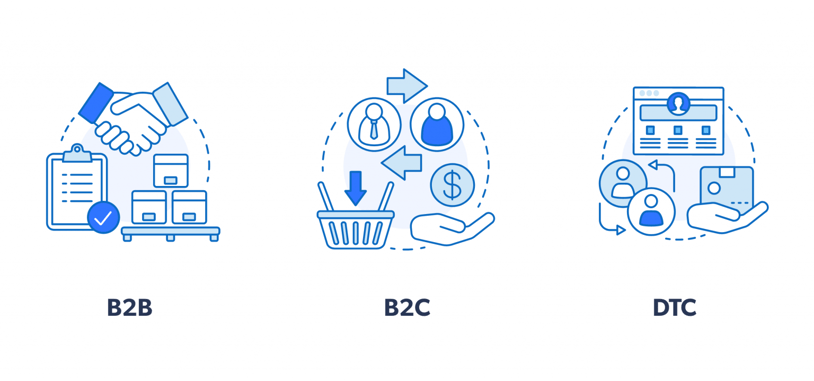
See why top ecommerce brands use Miva’s no-code platform to run
multiple stores, manage massive catalogs, and grow their revenue.
Ecommerce (also known as electronic commerce) is the buying and selling of goods and services over the Internet. With the help of electronic systems, today’s shoppers can purchase just about everything online. This on-demand convenience has allowed global ecommerce to skyrocket, with sales projected to reach $5 trillion by 2023.
Although the concept of online shopping is a given in our technology-driven world, ecommerce is only a little over 20 years old. Despite being a relatively recent phenomenon, ecommerce has dramatically changed the way we do business. In this article, we explain the concept of ecommerce and how buying and selling online has become as familiar to us as visiting the local grocery store. Read on or jump to a section below to learn more:
Ecommerce sites are digital spaces that facilitate the exchange of goods and funds between a buyer and a seller. They require maintenance, marketing, policies, IT, accounting, and customer support, just like any other business.
At its core, every ecommerce website is powered by an ecommerce platform or shopping cart software, stocked with tools and a central hub that help sellers create great online shopping experiences. Effective platforms must provide sellers with robust, flexible tools, integration, and the ability to scale.
These virtual storefronts can take various forms in addition to online stores, including auction sites, online reservations, and internet banking. The ubiquity of smartphones has also given rise to “m-commerce” (mobile commerce), a subset of ecommerce.
While technology like Electronic Data Exchange and Electronic Funds Transfer opened up commercial buying online in 1994, ecommerce didn’t start catching on with the public until about the late 1990s, when security protocols and increased internet access made it possible to purchase goods using secure payment methods and an electronic checkout.
For more on how it all began, check out our in-depth article on the history of ecommerce.
There are five main types of business models that describe the various transactions that occur on the web. These are:


Like every industry, the field of ecommerce has its own terminology that describes how goods are sourced, sold, and distributed. Businesses should be familiar with the following terms when planning and executing their strategy.
Retail: Stores that sell products directly to customers. These products can either be physical (products that involve a physical inventory and shipping to a customer) or digital (products that involve downloadable goods or licenses). A growing number of stores are also implementing initiatives such as in-store pickup.
Dropshipping: Selling a product that is manufactured and shipped by a third party to a customer.
Wholesale: A business that sells products in bulk amounts with quantity discounts, usually from one business to another.
Crowdfunding: An organization or company that collects funds from consumers to raise the capital necessary to introduce a new product or service to the market.
Subscription: An ecommerce subscription product or service that is automatically purchased and fulfilled to the subscriber.

Ecommerce is conducted online, whereas traditional retail is performed via a brick-and-mortar store. Today, many merchants are embracing a “bricks-and-clicks” model, leveraging both traditional retail and ecommerce.
Retailers both large and small are using ecommerce to sell directly to their customers and stay competitive. B2B and B2C websites are starting to mimic each other, while online marketplaces continue to rise. The way businesses conduct their logistics and market their products have changed as customers (especially millennials) are frequently using the internet to shop.
Interest in ecommerce has skyrocketed in the past couple of years, particularly during the time when efforts to limit the spread of COVID-19 resulted in massive disruption of brick-and-mortar businesses. Businesses (and consumers) are capitalizing on the advantages of online shopping, which include:
Although ecommerce offers businesses convenience and profitability, it still comes with its own set of disadvantages. Some of the pitfalls of ecommerce include:
Despite these limitations, ecommerce can offer businesses with limitless growth potential and game-changing profitability. While the elements vary from industry to industry, a spectacular shopping experience lies at the core of a successful site. This encompasses a visually pleasing appearance and a functional interface that effectively encourages and facilities online purchases.
Some of these important elements are:

Every holiday season, ecommerce sales continue to increase as more people see the convenience of online shopping and free shipping and more businesses move their operations online.
Projections for the future of the ecommerce industry are very positive. With the growing use of smartphones, tablets, smart TVs and other Internet-enabled electronics, there will only be more ways to shop online.
Setting up an ecommerce store requires important steps like research, website development, launching, and marketing. Some key things to keep in mind when starting an online business are:

As the ecommerce industry continues to grow, there’s expansive potential for businesses to grab a piece of the ecommerce pie. Every year, new tools are developed to increase the connectivity between people, helping ecommerce businesses adapt to the needs of their shoppers.
Interested in learning more? Check out our Ecommerce Resource Center.
Love it? Share it!
No worries, download the PDF version now and enjoy your reading later...
Download PDF Miva
Miva
Miva offers a flexible and adaptable ecommerce platform that evolves with businesses and allows them to drive sales, maximize average order value, cut overhead costs, and increase revenue. Miva has been helping businesses realize their ecommerce potential for over 20 years and empowering retail, wholesale, and direct-to-consumer sellers across all industries to transform their business through ecommerce.
Visit Website